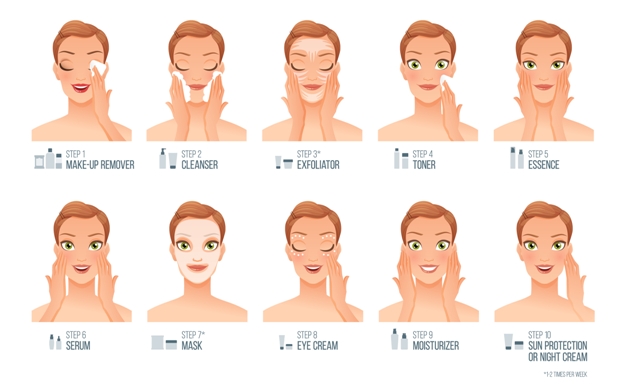As we grow older, the skin starts adapting to the lifestyle choices we have made, in addition to its own natural growth process. These life-choices or even just our skin makeup often lead to skin issues that need to be addressed. On the other hand, we definitely need to care for our skin to keep it healthy.
A good skincare routine not only gives you instant benefits, but it also plays an important role in the health of your skin even up to 30 years ahead
Your skincare routine has to be personalized as what works for another person might not necessarily work for you. Apart from your daily routine, you might also need to add routine enhancers to address issues like acne, uneven skin tone, dark spots, etc.
Here is a beginner’s guide to a personalized skincare routine. As with all things, consistency is key to reaping good results!
Simplicity is Key
If you are completely clueless as to what you need to build up your routine, we recommend you keep it simple with a three-step routine- cleanse, moisturize and apply sunscreen. The add-on to this would be products that would help your individual skincare needs. A perfect example would be considering an acne treatment if you are struggling with acne.
These three steps are a good foundation for a successful and effective skincare routine.
You want to avoid overwhelming your skin with a lot of products, especially if they are things you don’t necessarily need. It can be really tempting to stock up on a lot of products, without the guidance of a professional, this can further complicate issues.
Determine your Skin Type
All skin types have different needs, so you definitely want to know that you get the right products for your skin type.
There are basically four skin types
- Oily skin: Skin produces more oil than needed and appears shiny. Oily skin types do not need to splurge on oil-based products or rich moisturizing products. They would be more concerned with mattifying ingredients.
- Dry skin: Skin might feel tight, appears dry and flakey and sometimes might get so dry it appears to be peeling. You definitely want products that are rich moisturizers.
- Sensitive skin: Skin reacts easily, may include irritated areas that would be painful to the touch.
- Combination skin: Skin that is a combination of both dry and oily skin in different areas.
Finding your routine
Now its time to narrow down what products you want and what products you want to avoid.
Step 1: Choose a cleanser
The purpose of cleaners is to remove dirt, makeup residues, bacteria and oil that get on your skin as you go about your day or even while you sleep at night. This step is super important to help the other products absorb nicely on your face. Cleansing keeps your face fresh at the start and end of your day and prevents clogging of your pores.
If your skin is oily, you want to look out for a foaming cleanser that removes pore-clogging bacteria and excess oil, if you have dry skin, you want to look out for hydrating cleansers that would help restore the skins moisture barrier.
Step 2: Find the right moisturizer
As you go about your day, your skin loses water. Moisturizers can help replenish the water and provide hydration that your face needs to stay supple, youthful and soft.
A common misconception is that people with oily faces do not need to use moisturizers. Contrary to this belief, skipping moisturizers will not only cause your skin to dry out it will make your face to produce more oil, which will then cause breakouts and clogged pores. You want to look for non-comedogenic moisturizers, these are moisturizers that won’t clog pores. You want to steer clear of products with ingredients such are cocoa butter, lanolin, and mineral oil. Alternatively, you do want to reach for moisturizers that contain hyaluronic acid, aloe, glycerin, these ingredients will not trap oils in the pores.
Step 3: You need Sunscreen
We all need sunscreen, regardless of your race or skin type. Apart from preventing dark spots and wrinkles, it also reduces the risk of skin cancer.
You might not necessarily need to buy SPF separately, as some moisturizers contain SPF, however, you want to make sure it contains broad-spectrum SPF 30 or higher.
Putting it all together

Consistency is key when it comes to skincare, you need to give it time to work. Your skin will not change overnight, for most products, give it four to six weeks to start seeing noticeable results.
Once you have your routine, you want to consider products that will help deal with issues that need more than just moisturizing and cleansing.
Below are our favourite routine enhancers that work to target specific skincare issues.
Exfoliators
Exfoliating the skin helps deal with dryness and acne by removing dead skin cells.
Toners
Toners work to address signs of aging, redness or help balance the skin pH level.
Acne treatments
These should be applied immediately after using cleansers.
Skin Lightening
If you deal with a really bad uneven skin tone, or you just want your skin lighter than it is. These products help achieve that. Just a caution that every skin lightening should be paired with an SPF higher than 30.


